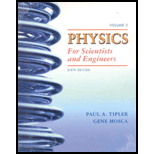
(a)
The points where object is in equilibrium.
(a)
Explanation of Solution
Given:
The potential energy function is
The potential energy function is
Formula used:
Write the expression for force in terms of potential energy.
Here,
Calculation:
For
Substitute
Calculate the equilibrium points.
For
Substitute
Object would be in neutral equilibrium for
Conclusion:
Thus, object is in equilibrium at
(b)
The graph for
(b)
Explanation of Solution
Given:
The potential energy function is
The potential energy function is
Formula used:
The energy contained in an object due to its position when compared to other objects is called potential energy.
Write the expression of potential energy for
Here,
Write the expression of potential energy for
Calculation:
Substitute
Substitute
Substitute
Substitute
Substitute
The graph for

Conclusion:
Thus, the graph for
(c)
The stable and unstable points of equilibrium.
(c)
Explanation of Solution
Given:
The potential energy function is
The potential energy function is
Formula used:
Write the expression for force in terms of potential energy.
Here,
Calculation:
For
Substitute
Calculate the equilibrium points.
For
Substitute
Object would be in neutral equilibrium for
Calculate the potential energy at all equilibrium points.
For
For
Conclusion:
The value of potential energy is maximum at
(d)
The speed of object at
(d)
Explanation of Solution
Given:
The potential energy function is
The potential energy function is
The mass of object is
The total energy of object is
Formula used:
Write the expression for potential energy.
Here,
Write the expression for change in kinetic energy.
Here,
Write the expression of total energy.
Here,
Substitute
Calculation:
Substitute
Substitute
Conclusion:
The speed of object at
Want to see more full solutions like this?
Chapter 7 Solutions
Physics for Scientists and Engineers, Vol. 3
- Cite two examples in which a force is exerted on an object without doing any work on the object.arrow_forwardConsider a block of mass 0.200 kg attached to a spring of spring constant 100 N/m. The block is placed on a frictionless table, and the other end of the spring is attached to the wall so that the spring is level with the table. The block is then pushed in so that the spring is compressed by 10.0 cm. Find the speed of the block as it crosses (a) the point when the spring is not stretched, (b) 5.00 cm to the left of point in (a), and (c) 5.00 cm to the right of point in (a).arrow_forwardRepeat the preceding problem, but this time, suppose that the work done by air resistance cannot be ignored. Let the work done by the air resistance when the skier goes from A to B along the given hilly path be —2000 J. The work done by air resistance is negative since the air resistance acts in the opposite direction to the displacement. Supposing the mass of the skier is 50 kg, what is the speed of the skier at point B ?arrow_forward
- A cyclist in a race must climb a 5 hill at a speed of 8 m/s. If the mass of the bike and the biker together is 80 kg, what must be the power output of the biker to achieve the goal?arrow_forwardA certain automobile engine delivers 2.24 104 W (30.0 hp) to its wheels when moving at a constant speed of 27.0 m/s ( 60 mi/h). What is the resistive force acting on the automobile at that speed?arrow_forwardCalculate the elastic potential energy of a spring with spring constant k = 225 N/m that is (a) compressed and (b) stretched by 1.00 102 m.arrow_forward
- Consider a particle on which a force acts that depends on the position of the particle. This force is given by . Find the work done by this force when the particle moves from the origin to a point 5 meters to the right on the x-axis.arrow_forwardIf the net work done by external forces on a particle is zero, which of the following statements about the particle must be true? (a) Its velocity is zero. (b) Its velocity is decreased. (c) Its velocity is unchanged. (d) Its speed is unchanged. (e) More information is needed.arrow_forwardA block of mass 0.500 kg is pushed against a horizontal spring of negligible mass until the spring is compressed a distance x (Fig. P7.79). The force constant of the spring is 450 N/m. When it is released, the block travels along a frictionless, horizontal surface to point , the bottom of a vertical circular track of radius R = 1.00 m, and continues to move up the track. The blocks speed at the bottom of the track is = 12.0 m/s, and the block experiences an average friction force of 7.00 N while sliding up the track. (a) What is x? (b) If the block were to reach the top of the track, what would be its speed at that point? (c) Does the block actually reach the top of the track, or does it fall off before reaching the top?arrow_forward
- Suppose you are jogging at constant velocity. Are you doing any work on the environment and vice versa?arrow_forwardTrue or False: The elastic potential energy of a stretched or compressed spring is always positive.arrow_forwardCan a non-conservative force increase the mechanical energy of the system?arrow_forward
 University Physics Volume 1PhysicsISBN:9781938168277Author:William Moebs, Samuel J. Ling, Jeff SannyPublisher:OpenStax - Rice University
University Physics Volume 1PhysicsISBN:9781938168277Author:William Moebs, Samuel J. Ling, Jeff SannyPublisher:OpenStax - Rice University Physics for Scientists and Engineers, Technology ...PhysicsISBN:9781305116399Author:Raymond A. Serway, John W. JewettPublisher:Cengage Learning
Physics for Scientists and Engineers, Technology ...PhysicsISBN:9781305116399Author:Raymond A. Serway, John W. JewettPublisher:Cengage Learning Physics for Scientists and Engineers: Foundations...PhysicsISBN:9781133939146Author:Katz, Debora M.Publisher:Cengage Learning
Physics for Scientists and Engineers: Foundations...PhysicsISBN:9781133939146Author:Katz, Debora M.Publisher:Cengage Learning Principles of Physics: A Calculus-Based TextPhysicsISBN:9781133104261Author:Raymond A. Serway, John W. JewettPublisher:Cengage Learning
Principles of Physics: A Calculus-Based TextPhysicsISBN:9781133104261Author:Raymond A. Serway, John W. JewettPublisher:Cengage Learning College PhysicsPhysicsISBN:9781285737027Author:Raymond A. Serway, Chris VuillePublisher:Cengage Learning
College PhysicsPhysicsISBN:9781285737027Author:Raymond A. Serway, Chris VuillePublisher:Cengage Learning Glencoe Physics: Principles and Problems, Student...PhysicsISBN:9780078807213Author:Paul W. ZitzewitzPublisher:Glencoe/McGraw-Hill
Glencoe Physics: Principles and Problems, Student...PhysicsISBN:9780078807213Author:Paul W. ZitzewitzPublisher:Glencoe/McGraw-Hill





